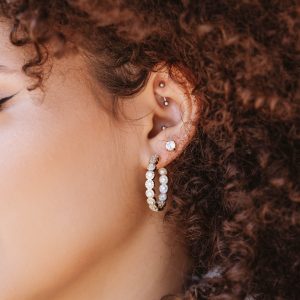
Ear piercing is a popular choice for many individuals, but with it comes the risk of infections, particularly if the piercing is not performed under optimal conditions.
Choosing medical piercing over traditional methods can significantly reduce these risks. Here’s how medical piercing prevents ear infections and ensures a safer experience.

Medical piercing refers to the practice of having ear or other body piercings done in a clinical setting by trained medical professionals.
Unlike traditional piercing methods that may occur in less controlled environments, medical piercing involves stringent cleanliness and specialized equipment. This approach is designed to minimize the risk of infection and ensure a safer process for the individual.
For infants and young children, the use of sterile techniques is crucial. Medical piercing procedures prioritize the highest standards of hygiene. This significantly reduces the risk of infection, a critical consideration for younger patients with more delicate skin.
The procedures are also designed to be as gentle and efficient as possible. Medical professionals use techniques that minimize discomfort and stress, making the experience less traumatic for infants. Their training ensures that they can handle children with the utmost care and sensitivity.
In medical piercing clinics, a method used is single-use sterile needles eliminating the risk of contamination from reused tools.
Another method is pre-packaged systems, such as the Blomdahl piercing system, where the piercing is done with sterile, pre-packaged jewelry and equipment, ensuring that everything that comes in contact with the skin is free from bacteria and other pathogens.
Medical piercing is performed in clean, controlled clinic settings that adhere to strict hygiene standards. These environments are designed to minimize exposure to potential contaminants, further reducing the risk of infection.
Professional medical staff follow rigorous procedures to maintain sterility throughout the piercing process, from preparation to execution.
The choice of jewelry used in medical piercing also plays a crucial role in infection prevention. Medical-grade jewelry, often made from hypoallergenic materials such as medical plastic or titanium, is designed to be compatible with sensitive skin and reduce the likelihood of allergic reactions.
An example of hypoallergenic jewellery is Blomdahl jewellery, crafted specifically to safeguard against infection, making it especially ideal for children and babies.

Traditional piercing methods, often performed in non-medical settings, can expose individuals to higher infection risks due to:
In contrast, medical piercing provides a controlled, sterile environment and uses specialized equipment, making it a safer choice for those concerned about infection.
Choosing medical piercing offers significant advantages in preventing infections. By utilizing sterile equipment, maintaining a clean environment, and using hypoallergenic jewelry, medical piercing clinics provide a safer and more hygienic option for those seeking piercings.
Ready to experience the benefits of medical piercing? Book an appointment with our experienced professionals today in Ontario or Calgary and ensure a safe and hygienic procedure.